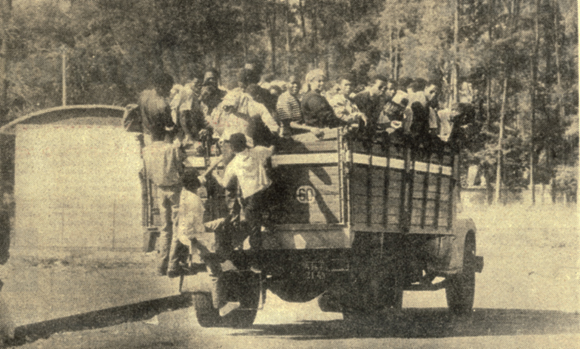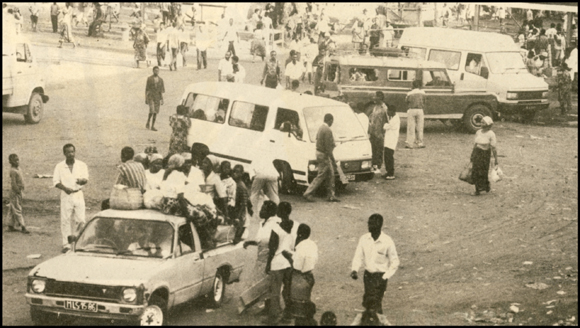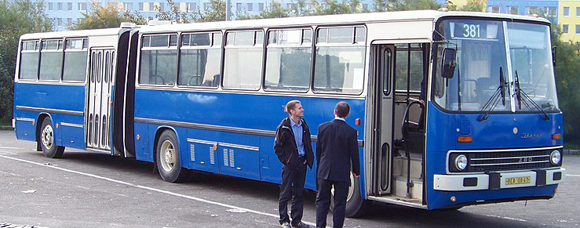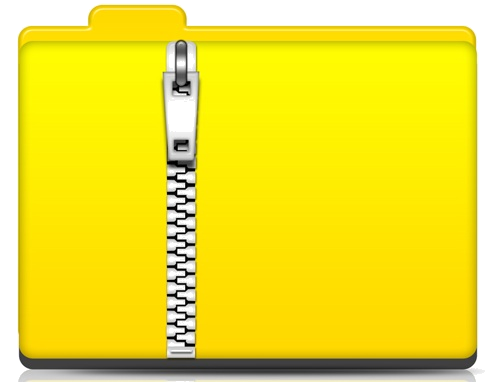Transport: Urban Mass Transit
1978-1994
Dossier MZ-0357 (partial)
![]()

Above: Passengers clinging on to a ‘My Love’ lorry. The English term was used ironically by city-dwellers to describe open trucks used for mass transit. Passengers stood together on the flat bed of the trucks and had to cling tightly to the stranger next to them to avoid losing their balance on corners or in the event of sudden stops. Accidents were frequent, and this mode of transport is now banned.
Mozambican towns and cities have generally lacked well-organised and well-regulated mass transportation, and this problem has not been solved in the 21st century.
Between 1904 and 1936 a system of electric trams operated in Maputo (click here for a short account of the Maputo tramways). However, no urban train or metro networks have been constructed, and for most people in towns and cities simply getting to work is a chaotic, dangerous, and unaffordable enterprise. The danger comes not only from the risk of accidents but also from criminal violence.
Passengers on public transport (alongside pedestrians and cyclists) are among those most at risk of injury or death in road accidents, according to 2003 research. Commuters wait for hours to board a vehicle; they are crammed into them without respect for their comfort or dignity and must pay exorbitant surcharges for any extra distance beyond routes that are often arbitrarily shortened by the drivers and operators. At present (2020-2021), private taxis are reliable in some areas of Maputo but are too expensive for most ordinary Mozambicans.

Above: A scene with chapa cem minibus taxis, Maputo, 1994.
In the immediate post-independence period, conventional bus services provided most of the available mass transit in greater Maputo and other urban centres. The local bus company TPU (Transportes Públicos Urbanos) invested in a fleet of Hungarian Ikarus articulated buses (picture above), but these proved difficult to maintain and soon broke down: in July 1984 it was reported that 81 of these machimbombos, to use the popular local term, were under repair. Maintenance has remained a constant problem: in 2006 only 35 of TPU’s 80 large diesel buses were operational, although the company’s fleet also included other types of vehicles.
Various attempts have been made to rationalise mass transit, but these have often consisted of small-scale projects that were tactical rather than strategic and could be summarised as too little, too late. In late 1983 the city council introduced a fleet of 20 Renault taxis, a measure that had minimal impact.
By the late 1980s unregulated minibus taxis known as chapa cem or simply chapas were appearing and soon became ubiquitous, although public dissatisfaction with high fares has resurfaced at regular intervals. The two major chapa associations, each operating between 1,500 and 2,200 15-seat reconditioned minibuses, are ATROMAP and UTRAMAP. By 2007-2008 the government had begun light regulation of the sector, standardizing fares on the main routes. Parts of some major traffic arteries, such as the lower stretch of Avenida Lénine, became one-way streets.
In 1993 rioting broke out, with one death and dozens of injured, when minibus fare were doubled overnight.

Above: An Hungarian-made Ikarus articulated bus photographed in 2010. Similar vehicles were operated by TPU in Maputo in the 1980s, but were found to be too difficult to maintain. (Cropped photograph used under CC licence: see here for details.
A 2006 report by USAID (Urban Transport Policy for Greater Maputo) described the system in rosy terms as “productive, dependable, and highly competitive… operat[ing] on a well-developed network of routes with minimal government interference” and recommended that the authorities should focus on traffic regulation and investing in bus infrastructure. Nevertheless, for most city-dwellers, access to mass transit remains a problem to be confronted on a daily basis. A book-length study of public mass transit policy by João Gabriel de Barros was published in 2018 as Políticas públicas de transporte rodoviário de passageiros: o seu impacto no desenvolvimento socioeconómico em Moçambique.
MHN Resources
![]()
Click on the yellow folder image below to download a zipped file of the dossier of press reports on mass transit in PDF format. The dossier is dated 2 March 2021 and contains 58 documents and reports. Note that additional files may be added from time to time.
![]()



![Aluka: Struggles for Freedom [subscription required] Struggles for Freedom](imgs/aluka_200.png)



